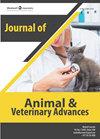Dietary Supplementation with Omega-3 Poly Unsaturated Fatty Acids Improves the Fertility in Adult Male Rats
引用次数: 0
Abstract
: This study aimed to assess the role of omega-3 PUNFs on male fertility using albino rats in order to get benefit from its use. For this study, fiftsy mature male albino rats weighing 250-300 g and aged 4-6 months were allocated randomly into 2 equal groups; group A that kept as control (n = 25) and group B (n = 25) where rats subjected to oral administration of omega-3 for 2 months in a dose of 375 mg kg G 1 body weight daily. The semen was collected from both groups after 8 weeks for detecting the sperm motility, count and abnormalities. Sera were used for determination of testosterone level. In addition, testis homogenate was used for measuring catalase and malondialdehyde activity. The body weight and sex organs (testis, prostate gland and seminal vesicles) weights were recorded in both groups. Histological examination of testis was performed. The obtained results revealed that group B; omega-3 treated group showed a significant increase in sperm motility, count, testosterone and catalase concentrations with a significant decrease in the percentage of abnormal spermatozoa and malondialdehyde concentration as compared with group A; control. Nochange in both body and sex organs weights was observed in treated group. In addition, numerous sperms in the lumen of the seminiferous tubules膳食中添加Omega-3多不饱和脂肪酸可提高成年雄性大鼠的生育能力
:本研究旨在使用白化大鼠评估ω-3 PUNF对雄性生育能力的作用,以从其使用中获益。在本研究中,将50只体重250-300g、年龄4-6个月的成年雄性白化大鼠随机分为2组;A组为对照组(n=25),B组为大鼠口服ω-3 2个月,每日剂量为375mg/kg G1体重。8周后从两组采集精液,检测精子活力、数量和异常情况。血清用于测定睾酮水平。此外,用睾丸匀浆测定过氧化氢酶和丙二醛的活性。记录两组的体重和性器官(睾丸、前列腺和精囊)重量。对睾丸进行组织学检查。结果表明:B组;与a组相比,ω-3处理组的精子活力、计数、睾酮和过氧化氢酶浓度显著增加,异常精子百分比和丙二醛浓度显著降低;控制治疗组的身体和性器官重量均无变化。此外,曲精管内腔中有大量精子
本文章由计算机程序翻译,如有差异,请以英文原文为准。
求助全文
约1分钟内获得全文
求助全文
来源期刊
自引率
0.00%
发文量
0
审稿时长
1 months
期刊介绍:
Journal of Animal Veterinary advances is a peer-reviewed, open-access scientific journal which publishes articles related to experiments, treatment, analysis, biological elements and other methods of research connected with veterinary. JAVA started publishing activity in 2002, since that time is updated twice a month, and is available in online and print formats. The publications are reviewed by Editorial Board in accordance with the standards and novelty of the subject, while strictly following ethical guidelines. Subject areas suitable for publication include, but are not limited to the following fields :: Veterinary science :: Animal husbandry :: Animal nutrition :: Anatomy :: Biological science :: Pathology :: Infectious diseases :: Animal physiology :: Animal breeding :: Animal biotechnology :: Transgenic animal production :: Animal parasitology :: Veterinary medicine :: Animal feed and nutrition :: Equine.

 求助内容:
求助内容: 应助结果提醒方式:
应助结果提醒方式:


